A π-Phase-Shifted Fiber Bragg Grating Partial Discharge Sensor toward Power Transformers
Abstract
:1. Introduction
2. Principle
2.1. Ultrasonic Sensing Principle of PS-FBG
2.2. Solution of Stress and Temperature Cross-Sensitivity
3. Experiment
4. Conclusions
Author Contributions
Funding
Data Availability Statement
Conflicts of Interest
References
- Li, S.; Li, J. Condition monitoring and diagnosis of power equipment: Review and prospective. High Volt. 2017, 2, 82–91. [Google Scholar] [CrossRef]
- Ma, G.; Wang, Y.; Qin, W.; Zhou, H.; Yan, C.; Jiang, J.; Ju, Y. Optical sensors for power transformer monitoring: A review. High Volt. 2021, 6, 367–386. [Google Scholar] [CrossRef]
- Markalous, S.M.; Tenbohlen, S.; Feser, K. Detection and location of partial discharges in power transformers using acoustic and electromagnetic signals. IEEE Trans. Dielectr. Electr. Insul. 2008, 15, 1576–1583. [Google Scholar] [CrossRef]
- Li, C.-R.; Ma, G.-M.; Qi, B.; Zhang, G.-J.; Su, Q. Condition monitoring and diagnosis of high-voltage equipment in China-recent progress. IEEE Electr. Insul. Mag. 2013, 29, 71–78. [Google Scholar] [CrossRef]
- IEEE Std C57.127-2007 (Revision of IEEE Std C57.127-2000); International Standard: IEEE Guide for the Detection and Location of Acoustic Emissions from Partial Discharges in Oil-Immersed Power Transformers and Reactors. IEEE: Manhattan, NY, USA, 2007; pp. c1–c47.
- Lundgaard, L.E. Partial discharge. XIII. Acoustic partial discharge detection-fundamental considerations. IEEE Electr. Insul. Mag. 1992, 8, 25–31. [Google Scholar] [CrossRef]
- Lundgaard, L. Partial discharge. XIV. Acoustic partial discharge detection-practical application. IEEE Electr. Insul. Mag. 1992, 8, 34–43. [Google Scholar] [CrossRef]
- Judd, M.D.; Li, Y.; Hunter, I.B.B. Partial discharge monitoring of power transformers using UHF sensors. Part I: Sensors and signal interpretation. IEEE Electr. Insul. Mag. 2005, 21, 5–14. [Google Scholar] [CrossRef]
- Zheng, S.; Li, C.; Tang, Z.; Chang, W.; He, M. Location of PDs inside transformer windings using UHF methods. IEEE Trans. Dielectr. Electr. Insul. 2014, 21, 386–393. [Google Scholar] [CrossRef]
- Cui, H.; Denghua, L. Research on Electromagnetic Interference Resistance of Piezoelectric Vibration Acceleration Sensor. Ferroelectrics 2014, 460, 82–97. [Google Scholar] [CrossRef]
- N’cho, J.S.; Fofana, I. Review of fiber optic diagnostic techniques for power transformers. Energies 2020, 13, 1789. [Google Scholar] [CrossRef]
- Jiang, J.; Song, Y.; Wang, K.; Lu, Y.; Li, J.; Ranjan, P.; Zhang, C. Partial discharge detection and sensitivity improvement for bushing based on optical interference technique. IEEE Trans. Power Deliv. 2021. [Google Scholar] [CrossRef]
- Zhou, H.Y.; Ma, G.M.; Zhang, M.; Zhang, H.C.; Li, C.R. A high sensitivity optical fiber interferometer sensor for acoustic emission detection of partial discharge in power transformer. IEEE Sens. J. 2019, 21, 24–32. [Google Scholar] [CrossRef]
- Sahota, J.K.; Gupta, N.; Dhawan, D. Fiber Bragg grating sensors for monitoring of physical parameters: A comprehensive review. Opt. Eng. 2020, 59, 060901. [Google Scholar] [CrossRef]
- Ma, G.M.; Jiang, J.; Mu, R.D.; Li, C.R.; Luo, Y.T. High Sensitive FBG Sensor for Equivalent Salt Deposit Density Measurement. IEEE Photonics Technol. Lett. 2015, 27, 177–180. [Google Scholar] [CrossRef]
- Jiang, J.; Ma, G.M.; Li, C.R.; Song, H.T.; Luo, Y.T.; Wang, H.B. Highly Sensitive Dissolved Hydrogen Sensor Based on Side-Polished Fiber Bragg Grating. IEEE Photonics Technol. Lett. 2015, 27, 1453–1456. [Google Scholar] [CrossRef]
- Lima, S.E.U.; Frazao, O.; Farias, R.G.; Araujo, F.M.; Ferreira, L.A.; Santos, J.L.; Miranda, V. Mandrel-Based Fiber-Optic Sensors for Acoustic Detection of Partial Discharges—A Proof of Concept. IEEE Trans. Power Deliv. 2010, 25, 2526–2534. [Google Scholar] [CrossRef]
- Sarkar, B.; Mishra, D.K.; Koley, C.; Roy, N.K.; Biswas, P. Intensity-Modulated Fiber Bragg Grating Sensor for Detection of Partial Discharges Inside High-Voltage Apparatus. IEEE Sens. J. 2016, 16, 7950–7957. [Google Scholar] [CrossRef]
- Lima, S.E.U.; Farias, R.G.; Araújo, F.M.; Ferreira, L.A.; Santos, J.L.; Miranda, V.; Frazão, O. Fiber laser sensor based on a phase-shifted chirped grating for acoustic sensing of partial discharges. Photonic Sens. 2012, 3, 44–51. [Google Scholar] [CrossRef]
- Ma, G.M.; Zhou, H.Y.; Shi, C.; Li, Y.B.; Zhang, Q.; Li, C.R.; Zheng, Q. Distributed partial discharge detection in a power transformer based on phase-shifted FBG. IEEE Sens. J. 2018, 18, 2788–2795. [Google Scholar] [CrossRef]
- Kersey, A.D.; Davis, M.A.; Patrick, H.J.; LeBlanc, M.; Koo, K.P.; Askins, C.G.; Friebele, E.J. Fiber grating sensors. J. Lightwave Technol. 1997, 15, 1442–1463. [Google Scholar] [CrossRef]
- Agrawal, G.P.; Radic, S. Phase-shifted fiber Bragg gratings and their application for wavelength demultiplexing. IEEE Photonics Technol. Lett. 1994, 6, 995–997. [Google Scholar] [CrossRef]
- Helleseth, T. Some results about the cross-correlation function between two maximal linear sequences. Discret. Math. 1976, 16, 209–232. [Google Scholar] [CrossRef]
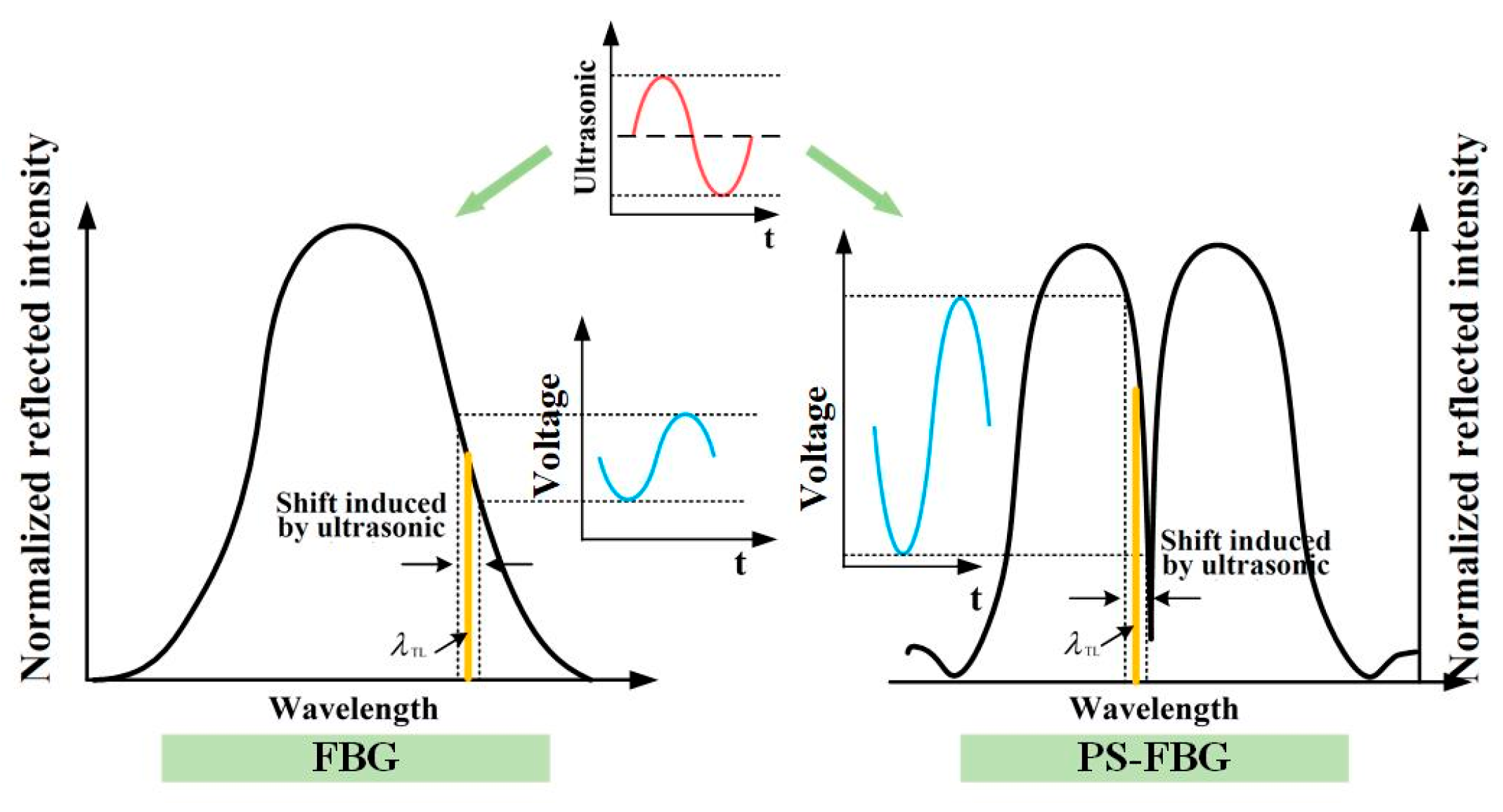
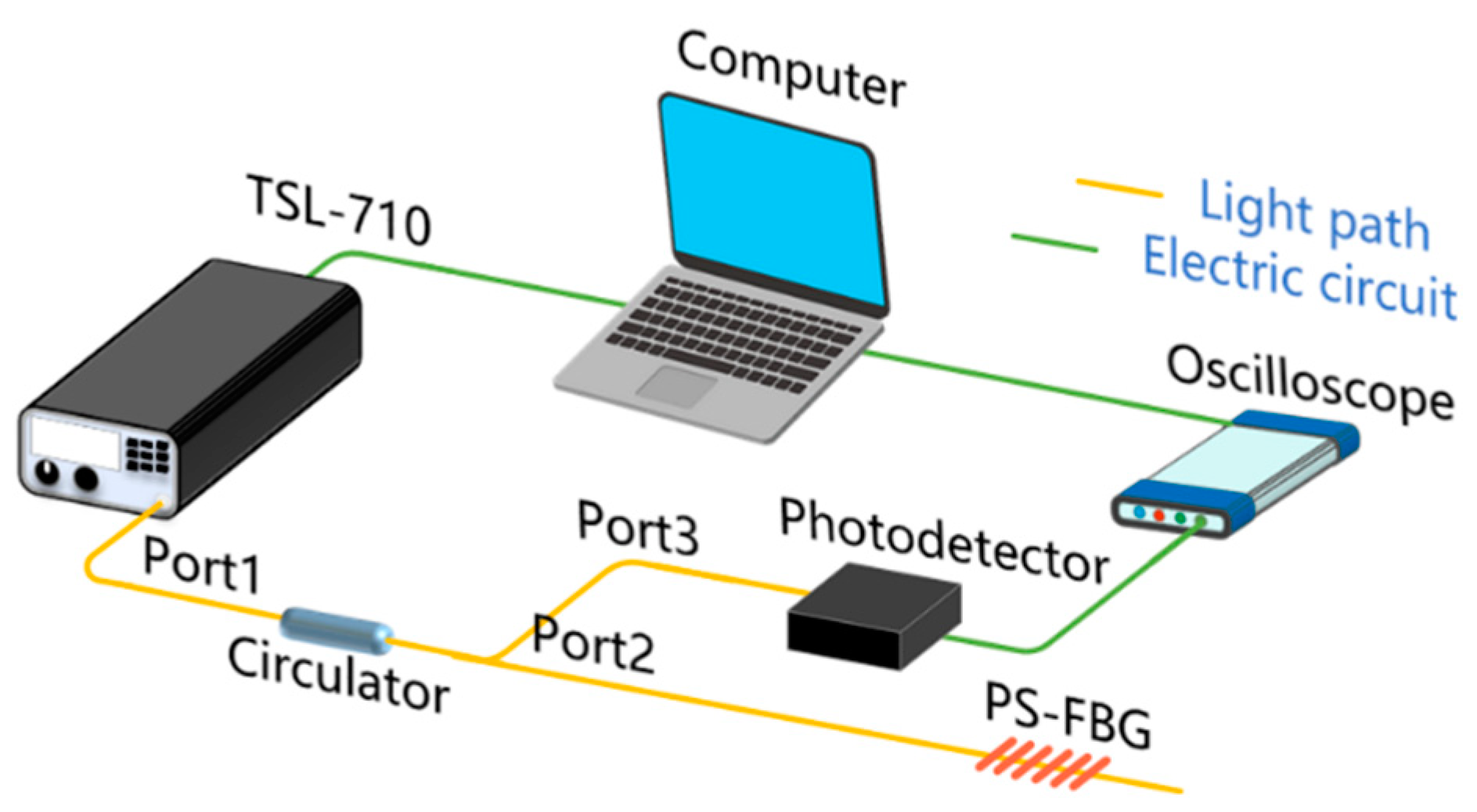
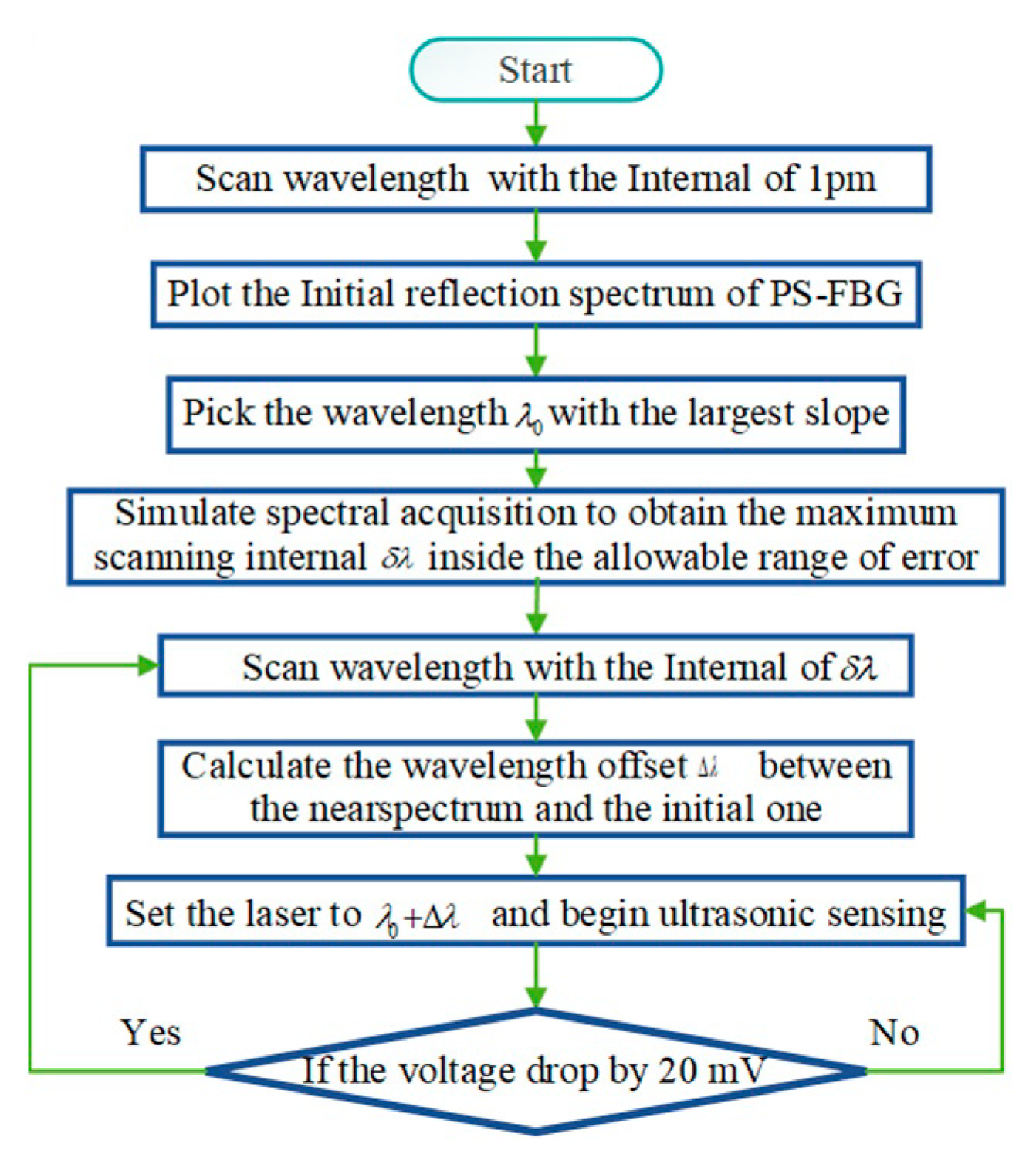


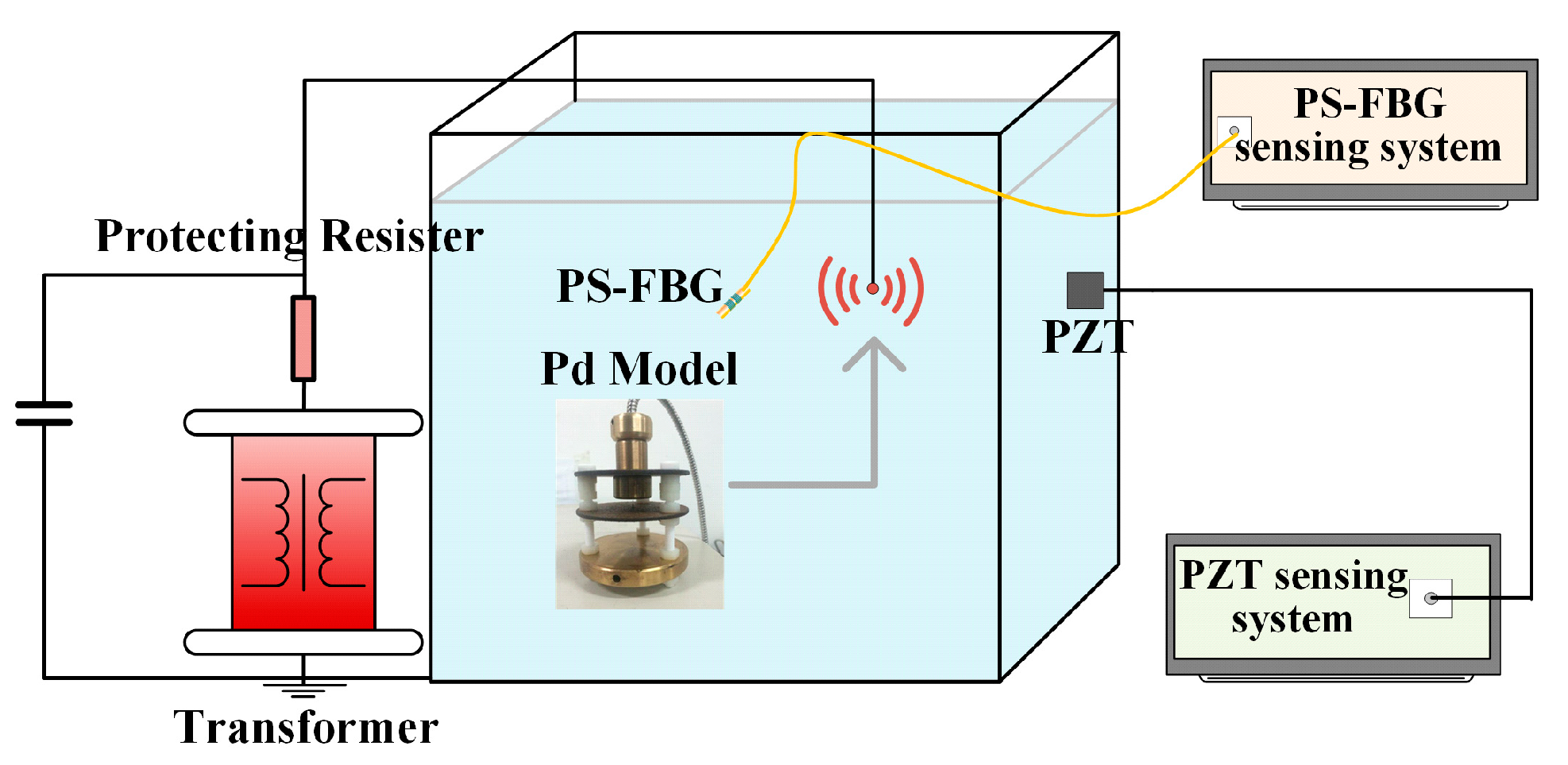
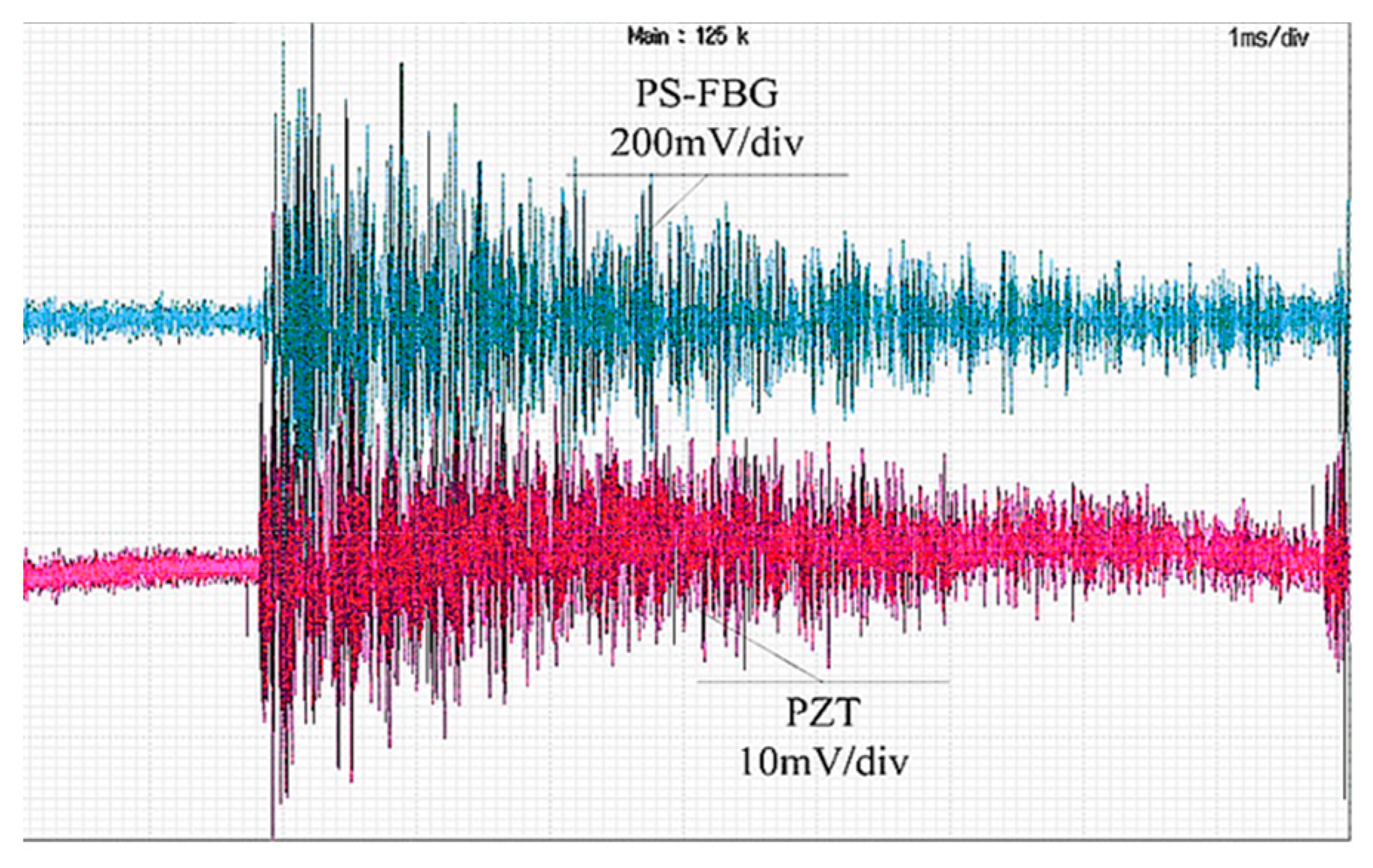
| Times | 1 | 2 | 3 | 4 | 5 | 6 |
|---|---|---|---|---|---|---|
| Voltage/mV | ||||||
| PS-FBG | 935 | 1561 | 950 | 1206 | 932 | 1058 |
| PZT | 63 | 72 | 65 | 69 | 54 | 55 |
| Multiple | 14.8 | 21.9 | 14.6 | 17.5 | 17 | 19.2 |
| Average multiple | 17.5 | |||||
Publisher’s Note: MDPI stays neutral with regard to jurisdictional claims in published maps and institutional affiliations. |
© 2022 by the authors. Licensee MDPI, Basel, Switzerland. This article is an open access article distributed under the terms and conditions of the Creative Commons Attribution (CC BY) license (https://creativecommons.org/licenses/by/4.0/).
Share and Cite
Tian, T.; Zhou, X.; Wang, S.; Luo, Y.; Li, X.; He, N.; Ma, Y.; Liu, W.; Shi, R.; Ma, G. A π-Phase-Shifted Fiber Bragg Grating Partial Discharge Sensor toward Power Transformers. Energies 2022, 15, 5849. https://doi.org/10.3390/en15165849
Tian T, Zhou X, Wang S, Luo Y, Li X, He N, Ma Y, Liu W, Shi R, Ma G. A π-Phase-Shifted Fiber Bragg Grating Partial Discharge Sensor toward Power Transformers. Energies. 2022; 15(16):5849. https://doi.org/10.3390/en15165849
Chicago/Turabian StyleTian, Tian, Xiu Zhou, Sihan Wang, Yan Luo, Xiuguang Li, Ninghui He, Yunlong Ma, Weifeng Liu, Rongbin Shi, and Guoming Ma. 2022. "A π-Phase-Shifted Fiber Bragg Grating Partial Discharge Sensor toward Power Transformers" Energies 15, no. 16: 5849. https://doi.org/10.3390/en15165849
APA StyleTian, T., Zhou, X., Wang, S., Luo, Y., Li, X., He, N., Ma, Y., Liu, W., Shi, R., & Ma, G. (2022). A π-Phase-Shifted Fiber Bragg Grating Partial Discharge Sensor toward Power Transformers. Energies, 15(16), 5849. https://doi.org/10.3390/en15165849





